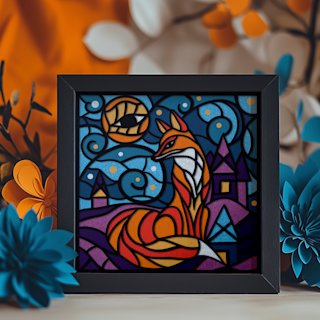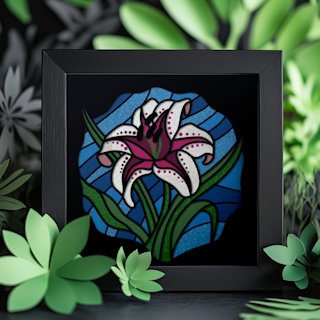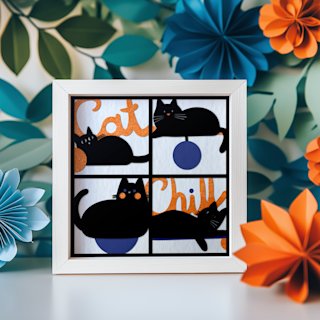2. Textured Cardstock
- Best for: 3D projects, handmade cards, invitations
- Weight: 80–110 lb (216–300 gsm)
- Features: Subtle texture adds depth and luxury
- Pro Tip: Use textured cardstock for shadow box backdrops to create a dimensional
effect.
Textured cardstock shines in projects with larger, simpler shapes where the texture can be
appreciated without
risking damage. Avoid textured cardstock for highly intricate designs and layered
designs with
many pieces - smooth cardstock is easier to align and layer precisely.
3. Glitter Cardstock
- Best for: Decorative accents, party decorations, cake toppers
- Weight: 100–120 lb (270–325 gsm)
- Features: Sparkly surface, often coated for durability
- Pro Tip: The glitter particles can dull your blade faster, making it harder to
achieve clean,
precise cuts over time.
A StrongGrip Mat will hold the glitter cardstock firmly in place, preventing it from
shifting
during cutting. This is especially important because the glitter layer can make the paper less
adhesive. Glitter
can accumulate on your blade and mat, affecting performance. Clean both regularly to maintain clean
cuts.
Glitter cardstock can add a dazzling, festive touch to your Cricut projects, but it’s best suited for
simpler
designs or as an accent. For intricate projects, smooth cardstock is usually the better choice.
- Best for: Elegant invitations, gift tags, business cards, festive crafts
- Weight: 80–120 lb (216–325 gsm)
- Features: Shiny or reflective surface, adds sophistication
- Pro Tip: Cheaper versions may have uneven coatings or flake during cutting.
Invest in
high-quality materials for cleaner, more professional results.
Foil and metallic cardstock work best for projects with bold shapes or moderate
details where
the shine can stand out without risking damage. The coating can dull your blade faster, making it
harder to
achieve clean, precise cuts over time.
If you love the look of foil or metallic finishes but need precision, consider pairing these
materials with
smooth cardstock in your designs. For example, use foil or metallic paper for accents or backgrounds
and smooth
paper for intricate cutouts.
5. Vellum Cardstock
Vellum is a translucent, delicate paper that adds an elegant, ethereal touch to your
projects.
- Best for: Layered effects, shadow box inserts, elegant overlays
- Weight: 48–65 lb (176 gsm)
- Features: Translucent finish, soft and delicate look
- Pro Tip: Use vellum with LED-lit shadow boxes for a dreamy, glowing effect.
Vellum is delicate, so it requires some special care when cutting. Use light to medium pressure to
avoid tearing.
Test on a small piece first to find the perfect setting. A StandardGrip or a fresh LightGrip Mat is
ideal for
vellum because it provides enough adhesion without being too strong. A StrongGrip Mat can make it
difficult to
remove vellum without tearing.
Avoid vellum cardstock for projects requiring durability (vellum is delicate and not
suitable
for items that will be handled frequently), for heavy adhesive use - glue and tape can show through
vellum, so use
adhesive sparingly or opt for hidden attachment methods (e.g., brads, stitching).
Want something rustic? Let’s talk about Kraft cardstock next!
6. Kraft Cardstock
- Best for: Rustic-style crafts, eco-friendly designs, scrapbooking
- Weight: 80–100 lb (216–270 gsm)
- Features: Natural brown tone, thick and sturdy
- Pro Tip: Perfect for earthy, minimalist designs. Combine with bold, intricate
cutouts for
contrast.
The edges of kraft cardstock can sometimes fray after cutting. Use a fine-grit
sandpaper or an
emery board to smooth any rough edges. Kraft cardstock is a durable, eco-friendly material that adds a
warm,
rustic charm to your Cricut projects. While it’s not ideal for highly intricate designs, it’s perfect
for bold
shapes, packaging, and projects with a handmade feel.



